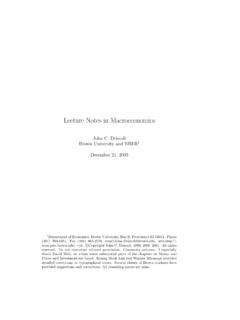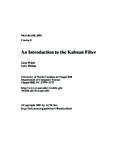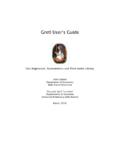Transcription of Stationarity and Cointegration analysis
1 Stationarityand Cointegration analysisBy Tinashe unit root testing Cointegration Vector Auto-regressions Cointegration in Multivariate systems introduction Stationarityorotherwiseofaseriescanstron glyinfluenceitsbehaviourandproperties. Forinstancea shock diesawaywithstationaritybutispersistenti fnonstationary. Spuriousregressions -ifvariablesaretrendedovertimeitmayprodu cesignificantcoefficientsandhighR2butiti sameaninglessrelationship. Twotypesoftrend StochasticTrend-[randomwalk] DeterministicTrend Whydistinguishbetweenthem? Maylookthesamebuthaveverydifferentproper tiesDeterministic trendsDeterministic trends Taking the first difference of a trend stationary series removes the non-stationaritybut at the cost of introducing an MA(1) process in the invertible MA process cannot be written as an AR processDeterministic trendStochastic trends Consider the followingStochastic trends Take this process forward Speriods in time: As S approaches infinity the values of Y do not become independent of the error terms.
2 And the drift term increases over time This process is know as the stochastic trend because it is dependent on the drift and the stochastic progression of error termsStochastic trendDetecting unit root -dickey fuller tests Dickey and Fuller (Fuller, 1976; Dickey and Fuller, 1979).-pioneers on testing for a unit root in time series The basic objective of the test is to examine the null hypothesis that: Against a one sided alternativeDickey Fuller testsReject Null if DF statistic is more negative than the critical valuesAugmented Dickey Fuller unit root Test Augmented Dickey Fuller unit root Test TheADFtestrequiresaspecificlaglengthtoau gmenttheautoregressiveprocessofYtsoastos oakanydynamicstructurepresentinthedepend entvariableandtoexpungeanypossibleserial correlationintheregressionresiduals.
3 However: largerlaglengthmayincreasethestandarderr orsofthecoefficients-degreesoffreedomare usedup. lowerlaglengthwillnotremovealltheautocor relationandwillbiastheestimatedresults(E nders,2010;andBrookes,2010). Useinformationcriteriontochooselaglength An EviewsDemonstration unit root testingAugmented Dickey Fuller resultsComputed valueOrder of integration A time series is said to be integrated of order d, I(d), if after differencing d times it becomes stationary If a variable is stationary it is said to be I(0) If the first difference of a non stationary variable is stationary it is said to be I(1) Most economic data is I(1)Why are we concerned about the order of integration?
4 Has a direct bearing on the appropriateness and statistical validity of regression results If we wish to regress Y on X when: Ytand Xtare stationary, classical OLS is valid Ytand Xtare integrated of different orders, regression is meaningless Ytand Xtare integrated of same order and residuals are non stationary, regression may be spurious Ytand Xtare integrated of same order and residuals are stationary, regression may indicate a cointegratingrelationships CLR is founded on asymptotctheory, which implies convergence of variance on a constant This is not the case when variables are non stationary-sample moments converge to Brownian Motion or Weiner ProcessesConsequences of non Stationarity Sampling distributions take a non standard form We can no longer rely on t and Fdistributions in statistical inference Normal hypothesis testing is invalidated There is a tendency to reject the null of no association between individual and all regressorsjointly-the probleonly intensifies withanincrease in the sample sizeHigh level over-view on CointegrationIntroduction Modern econometric analysis
5 Emphasise the importance of unit root testing in conducting empirical econometric work. Granger and Newbold(1974) non-stationary data yield misleading or spurious regression results regressions that do not make sense Results exhibit high R2values which converge to 1, high F and t-statistics and very low Durbin Watson statistics (serial correlation in residuals. Phillips (1986) a pioneer on asymptotic theory with I(1) variables, concurs with Granger and Newboldand proves that in the above regression: While beta parameters should converge to zero as sample size approaches infinity, they are non zero; R2statistics approach ;and T-statistics approach infinity.)
6 Brooks (2010), results reflect contemporaneously correlated time trends instead of the true underlying relationships introduction To avoid spurious regressions and to compute BLUE parameters variables are often differenced to achieve Stationarity However, economic and finance theory is anchored on long run relationship and differencing removes long run information from the data seriesCointegration Engle and Granger (1987) it is possible to estimate valid regressions using non-stationary data. Develop a technique to estimate valid parameters and to test for longrunrelationships between nonstationaryvariable (Granger Representation Theorem) A set of non-stationary variables integrated of the same order, say I(1), are linked to form an equilibrium relationship spanning the long-run if they combine to form a lower order series integrated of the order I(0), they are said to becointegrated.
7 Cointegration Thisimpliesthatvariableswillmovecloselyt ogetherandwillnotdriftarbitrarilyovertim eandthedistancebetweenthemwillbestationa ry Theconceptofcointegrationmimicstheexiste nceofalong-runequilibriumrelationshiptow hichthevariablesconvergeovertime. thedistancethatthesystemisawayfromequili briumatanygiventimeistermedtheequilibriu merrorCointegration The distance that the system is away from equilibrium at any given time is termed the equilibrium error. It allows for a richer study of the short-run dynamics of adjustment towards equilibriumthrough the use of error correction models. Cointegration in bivariate systemsTesting for Cointegration (residuals based test) Cointegration and error correction Procedure in testing for CointegrationTwo step Engel and Granger procedure Step 1: Run a static regression in levels between the variables Save the residuals series: and Step 2: Test for stationary of residuals If stationary- Cointegration , proceed to estimate ECM If non stationary-No CointegrationStep 1:Estimating a static Longrunequation Go to Quick, then select estimateEquation on the drop down menuStep 1.
8 Estimating a static long run equation In the equation dialog box Type the equation you wish to estimate. Always remember to include a constantStep 1: long run equation resultsRecall spurious regressionsCaution Check whether the coefficients in the long-run equation conform to aprioriexpectations in terms of direction of the impact and not on the magnitude and significance of the coefficients. The Rsqrstatistic is useless and should not be 1: Creating a residual series/ equilibrium errorTo create a residuals series Go to the procbutton and select the Make residual series optionCreate residual series/ Equilibrium errorCreating residual series/ Equilibrium error Name the residual series and Click OKTesting for unit roots in the residualsOnce the residual series is createdClick on view and select the unit root testbuttonStep 2.
9 Testing for Cointegration Select the ADF test on the testType windowSelect the level buttonAlways select nonefor the ADF model when conducting unit root testsStep 2 residual testTheoretically, the ADF critical values are not validShould ordinarily be based on MacKinnon surface response functions, Harris, , in practiceADF is used as a proxy for the true critical valuesSince the ADF is more negative than the critical values we reject the null that the variables are not cointegratedStep 2: Estimating an error correction model Theerrorcorrectionmodelalsoknownasthedyn amicsofadjustmentareestimatedusingthelag geddifferencesofthedataseriesandthelagof theequilibriumerrorwehavecalculatedabove Estimating an error correction modelIn the equation dialogue box enter the variables in their differencesFirst difference of lm3 money supplyconstantLagged equilibrium errorEstimate an error correction (2 step model)Validregressions?
10 Error correction term/ Speed of adjustmentEstimating a one step EG Cointegration ECM equation After testing for Cointegration as above, proceed to estimate an error correcting model In the equation dialogue box type the following equation Lm3(-1) Captures the speed of adjustment towards equilibriumLongruncomponentShortrundynam icsCointegration-One step Engel Granger ProcedureError correction term/ speed of adjustment should always be negativeCalculation of Elasticities The elasticity of money demand to the changes in the longruvariables are calculated as follows: the elasticity of nominal gdp LNGDP elasticity=(coefficient of gdp)/(coefficient of adjustment= Therefore we would say that a 10% change in nominal income will result in an 18% change in the money demanded in the longrun.)




